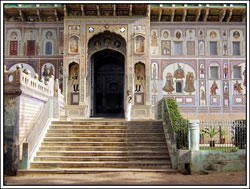 Located in the heart of the Shekhawati region, Mandawa is an excellent base for those seeking to discover what is known as "The Open Air Art Gallery of Rajasthan". This area is famous for the plethora of plain red havelis, all commendable pieces of the rich artistic tradition of this region known as Shekhawati. Havelis at Shekhawati built by rich merchants of the region, display a unique architectural style that evolved around the courtyards to ensure safety and privacy of the women folk and protection from the heat of the long and harsh summers. The havelis, painted predominantly in blue, maroon, yellow green and indigo have beautiful wall paintings that adorn their walls. The earlier wall paintings (1830 A.D. - 2900 A.D.) were largely based on the mythological themes, depicting local legends, animals, portraits, hunting and wrestling scenes and a glimpse of everyday life. The turn of 19th century saw the appearance of new motifs, an outcome of Raj's influence upon the Indian culture. Now, cars replaced elephants and traditional Indian miniatures mingled with naturalism of western paintings to produce interesting hybrid results. The mythological themes depicting wars, heroes, epics and legends were substituted by European oleographs, lithographs and photographs. Trains, cars, balloons, telephones, gramophones, English men in hunting attires and portraits of the haveli owners primely dressed, were painted all over the walls - thus making the havelis interesting for both Indian and foreign travellers.
Located in the heart of the Shekhawati region, Mandawa is an excellent base for those seeking to discover what is known as "The Open Air Art Gallery of Rajasthan". This area is famous for the plethora of plain red havelis, all commendable pieces of the rich artistic tradition of this region known as Shekhawati. Havelis at Shekhawati built by rich merchants of the region, display a unique architectural style that evolved around the courtyards to ensure safety and privacy of the women folk and protection from the heat of the long and harsh summers. The havelis, painted predominantly in blue, maroon, yellow green and indigo have beautiful wall paintings that adorn their walls. The earlier wall paintings (1830 A.D. - 2900 A.D.) were largely based on the mythological themes, depicting local legends, animals, portraits, hunting and wrestling scenes and a glimpse of everyday life. The turn of 19th century saw the appearance of new motifs, an outcome of Raj's influence upon the Indian culture. Now, cars replaced elephants and traditional Indian miniatures mingled with naturalism of western paintings to produce interesting hybrid results. The mythological themes depicting wars, heroes, epics and legends were substituted by European oleographs, lithographs and photographs. Trains, cars, balloons, telephones, gramophones, English men in hunting attires and portraits of the haveli owners primely dressed, were painted all over the walls - thus making the havelis interesting for both Indian and foreign travellers.